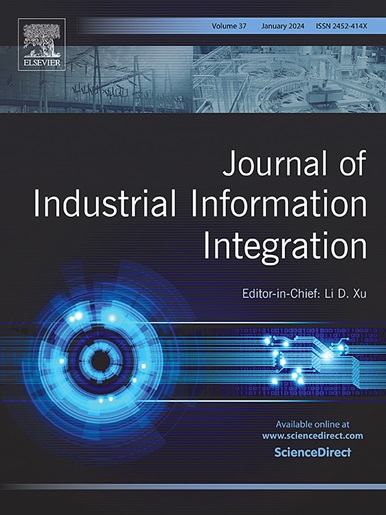基于深度迁移学习的轴向柱塞泵小样本双驱动跨域故障诊断
IF 10.4
1区 计算机科学
Q1 COMPUTER SCIENCE, INTERDISCIPLINARY APPLICATIONS
引用次数: 0
摘要
轴向柱塞泵是一个复杂而典型的热-流-固耦合系统。其可靠性直接影响到复杂液压系统的运行稳定性。它面临的挑战包括故障样本稀缺和不同运行条件下数据分布的差异。针对传统方法无法有效整合和利用多源信息,导致故障信息描述不完整的问题,本文提出了一种集成数字孪生和对抗传递的智能跨域工业信息集成故障诊断方法。首先,构建多域耦合数字孪生模型,生成多源故障仿真信息数据;该模型采用多体动力学与液压系统的联合仿真,保证了故障信息的物理保真度。多源融合格拉曼角和场特征编码旨在将多维信号映射到二维时空相关图像中,从而整合和增强信息的表示。其次,采用改进的多生成器辅助分类器生成对抗网络对模拟数据和实测数据的分布进行对齐,并采用动态优化策略提高生成质量;最后,结合梯度反转层和条件最大均值差异,构建了多尺度注意域对抗转移网络,抑制了仿真数据与实验数据的跨域分布差异。实验表明,通过整合实验和仿真数据,该方法在未知条件下的跨条件故障诊断任务中平均准确率达到98%以上,与传统迁移学习方法相比有显著提高。烧蚀实验验证了各模块的有效性,为小样本复杂液压系统故障诊断提供了一种新的方法。本文章由计算机程序翻译,如有差异,请以英文原文为准。
Digital Twin-driven cross-domain fault diagnosis for axial piston pumps via deep transfer learning under small-sample condition
Axial piston pump is a complex and typical thermal-fluid-structural coupled system. Its reliability directly affects the operational stability of the complex hydraulic system. It faces challenges including scarce fault samples and data distribution discrepancies across operating conditions. Regarding the problem that traditional methods fail to effectively integrate and utilize multi-source information, resulting in incomplete description of fault information, this paper proposes an intelligent cross-domain industrial information integration fault diagnosis method that integrates Digital Twin and adversarial transfer. Firstly, a multi-domain coupled Digital Twin model is constructed to generate multi-source fault simulation information data. The model employs co-simulation of multi-body dynamics and hydraulic systems to ensure the physical fidelity of fault information. Multi-source fused Gramian Angular Summation Fields feature encoding is designed to map multidimensional signals into two-dimensional spatiotemporal correlation images, thereby integrating and enhancing the representation of information. Secondly, an improved Auxiliary Classifier Generative Adversarial Network with multiple generators is adopted to align the distributions of simulated and measured data, with a dynamic optimization strategy employed to enhance generation quality. Finally, a Multi-scale Attention Domain Adversarial Transfer Network is constructed, combining a Gradient Reversal Layer and Conditional Maximum Mean Discrepancy to suppress the cross-domain distribution differences between the simulation and the experimental data. The experiment shows that by integrating experimental and simulation data, the proposed method achieves an average accuracy of over 98 % in cross-condition fault diagnosis tasks under unknown conditions, showing significant improvement over traditional transfer learning methods. Ablation studies validate the effectiveness of each module, providing a novel approach for complex hydraulic system fault diagnosis under small-sample scenarios.
求助全文
通过发布文献求助,成功后即可免费获取论文全文。
去求助
来源期刊

Journal of Industrial Information Integration
Decision Sciences-Information Systems and Management
CiteScore
22.30
自引率
13.40%
发文量
100
期刊介绍:
The Journal of Industrial Information Integration focuses on the industry's transition towards industrial integration and informatization, covering not only hardware and software but also information integration. It serves as a platform for promoting advances in industrial information integration, addressing challenges, issues, and solutions in an interdisciplinary forum for researchers, practitioners, and policy makers.
The Journal of Industrial Information Integration welcomes papers on foundational, technical, and practical aspects of industrial information integration, emphasizing the complex and cross-disciplinary topics that arise in industrial integration. Techniques from mathematical science, computer science, computer engineering, electrical and electronic engineering, manufacturing engineering, and engineering management are crucial in this context.
 求助内容:
求助内容: 应助结果提醒方式:
应助结果提醒方式:


